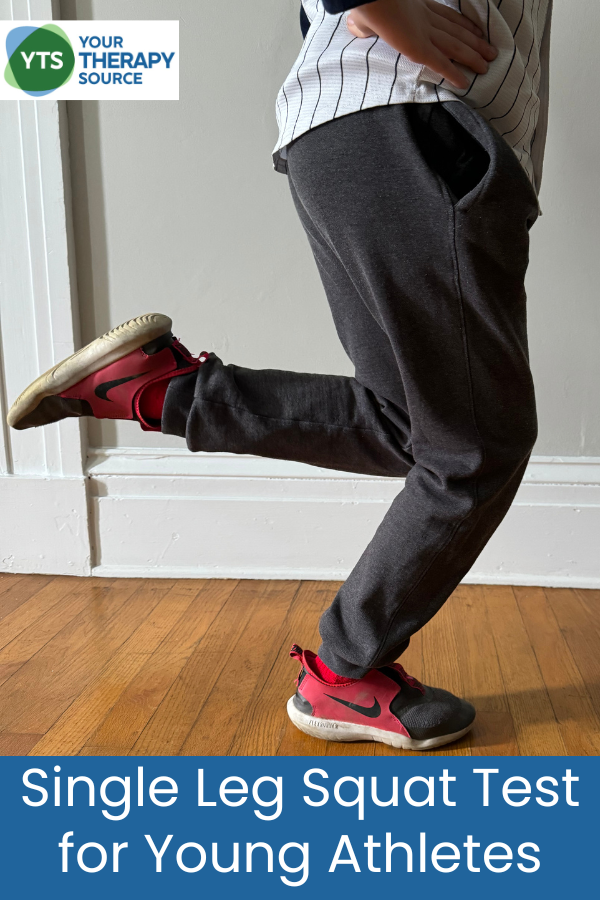Single Leg Squat Test in Youth

With over 30 million U.S. adolescents actively engaging in sports, understanding factors that influence performance and injury risk is crucial. Among the prevalent injuries in youth sports are lower extremity injuries, which comprise up to 89% of all such occurrences annually. The Single Leg Squat test (SLS) emerges as a straightforward, yet effective tool to assess lower extremity mechanics, often linked with injury risks in young athletes.
What Does the Research Say?
A pivotal study by Agresta et al. (2017) delved into the SLS performance across active adolescents aged 8–17 years, aiming to correlate the effects of age and biological maturity on their ability to perform SLS. The study involved 45 children, who were assessed outside their sports seasons to ensure unbiased results.
Key Findings
- Age as a Predictor: The research underscored age as a significant predictor of SLS performance. Younger athletes typically demonstrated poorer control and balance during the test. This finding suggests that younger athletes might experience a “motor awkwardness” period, aligning with their rapid adolescent growth spurts.
- Maturity and Performance: Contrary to initial hypotheses, maturity levels—determined through noninvasive peak height velocity (PHV) maturity offset—did not significantly alter SLS scores. This indicates that while biological maturity might refine the assessment of an athlete’s performance, it does not independently predict SLS competency.
- Importance of Balance: Interestingly, balance-related criteria (unilateral stance maintenance, arm strategy, and trunk movement) showed significant age-related improvement. This suggests that as children grow, their balance and trunk control enhance, directly boosting their SLS performance.
- Gender Differences: The study found no significant differences in SLS performance between genders, which challenges some previous findings suggesting gender-specific risk patterns in youth sports.

Thriving in Youth Sports
How to Score the Single Leg Squat Test
You can view all the details with the specific scoring here. The researchers created a scoring system based on 5 different categories. The child should perform 10 single leg squats to 60 degrees of knee flexion with hand on the hips. Here are the basics:
- Arm Strategy – used their arms to recover balance: 1 point
- Trunk Movement – trunk lean to either side: 1 point
- Pelvis Plane – Pelvic rotation or elevation on one side is observed: 1 point
- Knee Position – Mild knee medial deviation or other leg supports position: 1 point OR Moderate medial knee deviation: 2 points
- Maintain Unilateral Stance – puts other foot of the ground, unsteady leg or other leg supports tested side: 1 point.
Practical Applications for Young Athletes
This research provides essential insights for pediatric physical therapists, coaches, and trainers. Here’s how you can apply this knowledge:
- Age-Appropriate Training: Recognize the influence of chronological age on SLS performance. Younger athletes may benefit from targeted training focusing on improving balance and trunk control.
- Injury Prevention: Use the SLS test as a regular assessment tool to identify potential injury risks early, especially during the pre-season or when integrating new athletes into sports programs.
- Customized Interventions: Design training programs that are tailored to the developmental stages of young athletes. Such programs should prioritize foundational movements that enhance stability and strength.
- Continuous Monitoring: Given the variability in individual performance within the same maturity levels, continuous and personalized monitoring is essential. Adjust training and rehabilitation programs as young athletes grow and their performance evolves.
While the study by Agresta et al. highlights the non-significant impact of maturity on SLS performance, it emphasizes the crucial role of age in developing physical capabilities in youth athletes. For pediatric physical therapists and sports trainers, applying these insights can lead to more effective training strategies that cater to the developmental needs of young athletes, thereby enhancing their performance and reducing injury risks.
Other Tests Commonly Used by Pediatric Physical Therapists
Here’s a basic list of other tests besides the single leg squat test commonly used by pediatric physical therapists (PTs) to assess and monitor young athletes:
- Functional Movement Screen (FMS) – This test evaluates movement patterns that are key to identifying functional limitations and asymmetries which might increase the risk of injury.
- Gait Analysis – Used to assess the way an athlete walks or runs to pinpoint imbalances, inefficiencies, and asymmetries in their gait cycle.
- Balance Error Scoring System (BESS) – A simple test used to assess static postural stability, helpful in determining an athlete’s balance.
- Y Balance Test – Extends the BESS by measuring an athlete’s ability to maintain balance while reaching in different directions, useful for identifying potential limb asymmetries.
- Hop Tests – A series of tests that assess lower extremity strength, stability, and endurance. Includes single hop for distance, triple hop for distance, and crossover hop tests.
- Vertical Jump Test – Measures the maximum jump height and is often used to assess lower body power.
- Strength Tests – These might include handgrip strength testing or the use of isokinetic dynamometers to measure muscle strength at different joints.
- Range of Motion Measurements – Utilizes tools like goniometers or inclinometers to assess joint flexibility and movement capacity, which are crucial for identifying potential areas of restriction.
- Tanner Stage Assessment – A physical maturity assessment that helps categorize developmental stages in adolescents.
- Neurological Assessment – Basic tests to check motor skills and reflexes, ensuring neurological function is intact and appropriate for age.
These tests provide valuable insights into the physical capabilities and limitations of young athletes, aiding in the development of personalized training and rehabilitation programs.
Reference
Agresta, C., Church, C., Henley, J., Duer, T., & O’Brien, K. (2017). Single-leg squat performance in active adolescents aged 8–17 years. The Journal of Strength & Conditioning Research, 31(5), 1187-1191.



